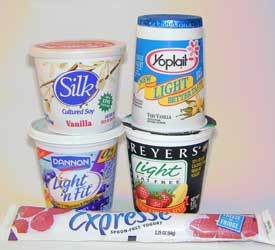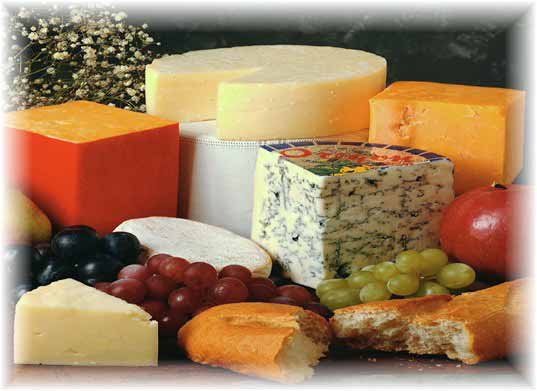|
~HmM..Yogurt!

Did you ever stop to think how yogurt was made or what's in that "yummy" strawberry flavored mush? You might not believe this, but bacteria actually helps to make yogurt. Bacteria contributes to the chemical breakdown (also called fermentation) of many diary products people eat everyday. Yogurt is produced by bacterial fermenation of milk. Lactobacillus bulgaricus produces lactic acid, which turns the milk sour, hampers the growth of disease-causing bacteria, and gives a desirable flavor to the resulting yogurt. So the next time you cringe when you hear the word "bacteria"...stop to think that yogurt you eat wouldn't have been made without bacteria. =)
~It's Invading Our Beloved Cheese!

|
| yUmM..Bacteria...i mean CheEse =) |
Another food product produced from bacteria is cheese. Yup, the same cheese that's on your delicious pizza and in your cheese pretzels. Cheese is made in three simple steps.
First, curds are formed when an enzyme called rennin is stirred into milk. Rennin encourages casein, one of the proteins in milk, to clump together. Rennin only works if the milk is slightly acidic, like when it is sour. Rather then waiting for the milk to sour, cheese makers speed up the process by warming the milk and adding specialized bacteria that convert the sugars in milk to lactic acid. As the casein clumps together, it forms moist, nutritious curds.
In the second step, the curds are seperared from the whey. (Remind you of Little Miss Tuffet?! =) ) The curds are cut into small chunks to drain the excess whey trapped inside. To produce cheeses high in moisture content, such as cottage cheese, cheese makers need to cut the curds and drain the whey before seasoning and packing the cheese into cartons for sale. Cheeses with lower moisture content undergo further treatment to condense the curds and remove more of they whey. The varying methods used to release excess whey play a large role in determining the final character of the cheese.
In the last step of cheese making is the ripening process. During this process, bacteria slowly change the composition of the curds, creating cheeses with distinct textures, flavors, and aromas. These type of bacteria used, the temperature and humidity conditions of the ripening environment, and the duration of the ripening process all contribute to the final characteristic of the cheese.
In Swiss cheese, the bacteria used produces gas bubbles during the ripening process which created the characteristic of holes or eyes. In other cases, bacteria is used to shape curds. For example, the blue-green mold called Penicillium roqueforti is used to ripen the cheeses such as Roquefort and Gorgonzola. This special mold created luish-green veins in the cheese and a characteristic sharp flavor and creamy texture. Other cheeses, such as Brie and Camembert, are ripened by bacteria rubbed on the outer surface of the cheese. The bacteria slowly work their way into the interior of the cheese, creating a soft, pungent interior and leaving a powdery, edible white rind on the outside.
|

|
| Who knew bacteria helped make alcohol?! |
The variety of foods produced from bacteria range from pickles, and olives, and sauerkaut to sausages and other cured meats and fish, chocolate, soy sauce, and other products. In most of these foods, bacteria play a major role because they produce lactic acid. Alcohol-producing yeasts are the primary fermentors in the manufacute of beer and wine, but lactic-acid bacteria also are involved, especially in making wine or cider. Bacteria that produce acetic acid can convert wine, cider, or other alcoholic beverages to vinegar. As you can see, many of the foods we love and devoure are made from bacteria. Still like those foods? (hehehe..)
|
 |
|
 |
|
 |
|
|

